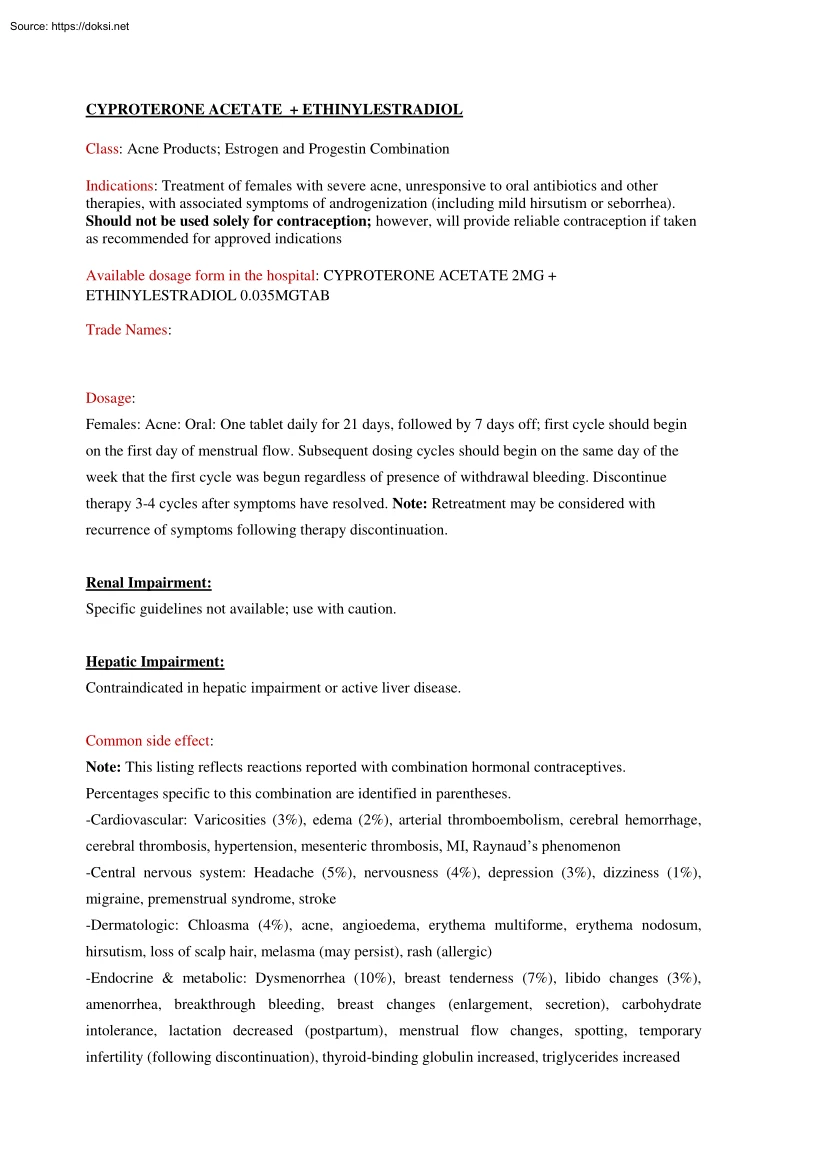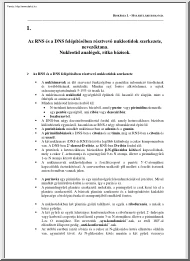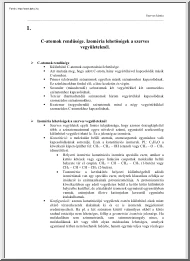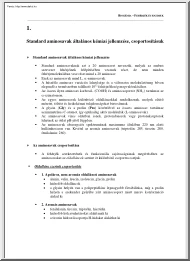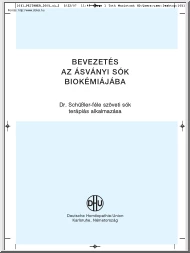Alapadatok
Év, oldalszám:2022, 2 oldal
Nyelv:angol
Letöltések száma:2
Feltöltve:2022. december 05.
Méret:722 KB
Intézmény:
-
Megjegyzés:
Csatolmány:-
Letöltés PDF-ben:Kérlek jelentkezz be!
Értékelések
Nincs még értékelés. Legyél Te az első!Tartalmi kivonat
CYPROTERONE ACETATE + ETHINYLESTRADIOL Class: Acne Products; Estrogen and Progestin Combination Indications: Treatment of females with severe acne, unresponsive to oral antibiotics and other therapies, with associated symptoms of androgenization (including mild hirsutism or seborrhea). Should not be used solely for contraception; however, will provide reliable contraception if taken as recommended for approved indications Available dosage form in the hospital: CYPROTERONE ACETATE 2MG + ETHINYLESTRADIOL 0.035MGTAB Trade Names: Dosage: Females: Acne: Oral: One tablet daily for 21 days, followed by 7 days off; first cycle should begin on the first day of menstrual flow. Subsequent dosing cycles should begin on the same day of the week that the first cycle was begun regardless of presence of withdrawal bleeding. Discontinue therapy 3-4 cycles after symptoms have resolved. Note: Retreatment may be considered with recurrence of symptoms following therapy discontinuation. Renal Impairment:
Specific guidelines not available; use with caution. Hepatic Impairment: Contraindicated in hepatic impairment or active liver disease. Common side effect: Note: This listing reflects reactions reported with combination hormonal contraceptives. Percentages specific to this combination are identified in parentheses. -Cardiovascular: Varicosities (3%), edema (2%), arterial thromboembolism, cerebral hemorrhage, cerebral thrombosis, hypertension, mesenteric thrombosis, MI, Raynaud’s phenomenon -Central nervous system: Headache (5%), nervousness (4%), depression (3%), dizziness (1%), migraine, premenstrual syndrome, stroke -Dermatologic: Chloasma (4%), acne, angioedema, erythema multiforme, erythema nodosum, hirsutism, loss of scalp hair, melasma (may persist), rash (allergic) -Endocrine & metabolic: Dysmenorrhea (10%), breast tenderness (7%), libido changes (3%), amenorrhea, breakthrough bleeding, breast changes (enlargement, secretion), carbohydrate intolerance, lactation
decreased (postpartum), menstrual flow changes, spotting, temporary infertility (following discontinuation), thyroid-binding globulin increased, triglycerides increased -Gastrointestinal: Nausea (2%), abdominal bloating/cramps, appetite changes, cholestasis, colitis, gallbladder disease, pancreatitis, vomiting, weight gain/loss -Genitourinary: Cervical erosion changes, cervical secretion changes, cystitis-like syndrome, endocervical hyperplasia, uterine fibroids (leiomyomata) enlarged, vaginal candidiasis, vaginitis -Hematologic: Factors VII, VIII, IX, and X increased; folate levels decreased, hemolytic uremic syndrome, porphyria, prothrombin increased -Hepatic: Alkaline phosphatase increased, AST increased, benign liver tumors, Budd-Chiari syndrome, cholestatic jaundice, GGT increased, hepatic adenomas, jaundice -Local: Thrombophlebitis -Neuromuscular & skeletal: Chorea, rheumatoid arthritis exacerbation, synovitis exacerbation -Ocular: Cataracts, change in corneal curvature
(steepening), contact lens intolerance, optic neuritis, retinal thrombosis -Otic: Auditory disturbances -Renal: Renal function impaired -Respiratory: Pulmonary thromboembolism, rhinitis -Miscellaneous: Hemorrhagic eruption, systemic lupus erythematosus (SLE) -Postmarketing and/or case reports (limited to important or life threatening): Abortion, exanthema, focal nodular hyperplasia, hepatic enzymes abnormal, hepatitis, herpes zoster, hyperprolactinemia, hyperthyroidism, hypoesthesia, missed abortion, myoma, neurodermatitis, ovarian cyst, palpitations, paresthesia, photosensitivity, pigmentation, placental insufficiency, salivary gland swelling, seizures, urinary tract infection, urticaria, vision abnormal. Pregnancy Risk Factor: Pregnancy should be ruled out prior to treatment and discontinued if pregnancy occurs. In general, the use of combination hormonal contraceptives when inadvertently taken early in pregnancy have not been associated with teratogenic effects. Upon discontinuation
of therapy, women should use a nonhormonal contraceptive to delay pregnancy until at least one normal cycle has occurred. Due to increased risk of venous thromboembolism (VTE) postpartum, combination hormonal contraceptives should not be started in any woman <21 days following delivery. Women without risk factors for VTE and who are not breast-feeding may start combination hormonal contraceptives during 21-42 days postpartum. After 42 days postpartum, restrictions for use are not related to postpartum status and should be based on other medical conditions
Specific guidelines not available; use with caution. Hepatic Impairment: Contraindicated in hepatic impairment or active liver disease. Common side effect: Note: This listing reflects reactions reported with combination hormonal contraceptives. Percentages specific to this combination are identified in parentheses. -Cardiovascular: Varicosities (3%), edema (2%), arterial thromboembolism, cerebral hemorrhage, cerebral thrombosis, hypertension, mesenteric thrombosis, MI, Raynaud’s phenomenon -Central nervous system: Headache (5%), nervousness (4%), depression (3%), dizziness (1%), migraine, premenstrual syndrome, stroke -Dermatologic: Chloasma (4%), acne, angioedema, erythema multiforme, erythema nodosum, hirsutism, loss of scalp hair, melasma (may persist), rash (allergic) -Endocrine & metabolic: Dysmenorrhea (10%), breast tenderness (7%), libido changes (3%), amenorrhea, breakthrough bleeding, breast changes (enlargement, secretion), carbohydrate intolerance, lactation
decreased (postpartum), menstrual flow changes, spotting, temporary infertility (following discontinuation), thyroid-binding globulin increased, triglycerides increased -Gastrointestinal: Nausea (2%), abdominal bloating/cramps, appetite changes, cholestasis, colitis, gallbladder disease, pancreatitis, vomiting, weight gain/loss -Genitourinary: Cervical erosion changes, cervical secretion changes, cystitis-like syndrome, endocervical hyperplasia, uterine fibroids (leiomyomata) enlarged, vaginal candidiasis, vaginitis -Hematologic: Factors VII, VIII, IX, and X increased; folate levels decreased, hemolytic uremic syndrome, porphyria, prothrombin increased -Hepatic: Alkaline phosphatase increased, AST increased, benign liver tumors, Budd-Chiari syndrome, cholestatic jaundice, GGT increased, hepatic adenomas, jaundice -Local: Thrombophlebitis -Neuromuscular & skeletal: Chorea, rheumatoid arthritis exacerbation, synovitis exacerbation -Ocular: Cataracts, change in corneal curvature
(steepening), contact lens intolerance, optic neuritis, retinal thrombosis -Otic: Auditory disturbances -Renal: Renal function impaired -Respiratory: Pulmonary thromboembolism, rhinitis -Miscellaneous: Hemorrhagic eruption, systemic lupus erythematosus (SLE) -Postmarketing and/or case reports (limited to important or life threatening): Abortion, exanthema, focal nodular hyperplasia, hepatic enzymes abnormal, hepatitis, herpes zoster, hyperprolactinemia, hyperthyroidism, hypoesthesia, missed abortion, myoma, neurodermatitis, ovarian cyst, palpitations, paresthesia, photosensitivity, pigmentation, placental insufficiency, salivary gland swelling, seizures, urinary tract infection, urticaria, vision abnormal. Pregnancy Risk Factor: Pregnancy should be ruled out prior to treatment and discontinued if pregnancy occurs. In general, the use of combination hormonal contraceptives when inadvertently taken early in pregnancy have not been associated with teratogenic effects. Upon discontinuation
of therapy, women should use a nonhormonal contraceptive to delay pregnancy until at least one normal cycle has occurred. Due to increased risk of venous thromboembolism (VTE) postpartum, combination hormonal contraceptives should not be started in any woman <21 days following delivery. Women without risk factors for VTE and who are not breast-feeding may start combination hormonal contraceptives during 21-42 days postpartum. After 42 days postpartum, restrictions for use are not related to postpartum status and should be based on other medical conditions
